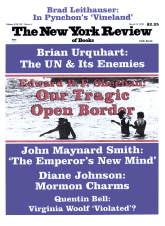In response to:
What Future for American Jews? from the November 23, 1989 issue
To the Editors:
Arthur Hertzberg asserts that the American Jewish community is “eroding” [“What Future for American Jews?” NYR, November 23, 1989]. Yet, much of the evidence he presents (and he by no means summarizes the available evidence) suggests otherwise. How can anyone write about failure and erosion of a community when there has been a systematic increase in the exposure to Jewish education, when the proportion observing religious and ethnic rituals associated with Passover and Hanukah have remained stable, when commitment to the survival of Israel and the family and ethnic networks are so powerful, and when Jewish political consciousness remains salient both about the State of Israel and about local and national American politics? Even Hertzberg recognizes this when he predicts that “strong ethnic identity will no doubt last for several more generations.”
What then concerns him? Somehow he is uncomfortable with the new ethnic dimensions of a transformed Jewishness and the new meanings of Judaism in a secular society, for a secular Jewry. Rabbi Hertzberg writes about the clear need for “some spiritual revival,” without which “American Jewish history will soon end, and become a part of American memory as a whole,” I doubt it. American Jews and their communities are stronger and more cohesive than in the past and it should be obvious to an historian like Hertzberg that the history of American Jews is not likely to repeat the histories of other Jewish communities; their past is not likely to be our future.
He suggests that intermarriage “is the single most sensitive indicator of the stability of the Jewish community,” and that the rates are increasing. Hence, he argues, “the optimistic belief that the Jewish community remained intact was unfounded.” Quoting a recent study of mine showing increasing rates of intermarriage among Jews, he concludes that I have become “less confident about the future” of American Jews. If he read further in that chapter, he would have noted the other half of the conclusion drawn from more detailed data. After reviewing the increase in Jewish intermarriages in America as a whole, we noted that “from a demographic perspective, these data suggest a gain from intermarriage, both through the non-Jewish spouses who have converted to Judaism and through the children of the intermarriages who are identified as Jews. What is not ascertained here is the depth or quality of the Jewish identification.” In short there may be changes in the quality of Jewish life, particularly in its religious dimensions, but increases in intermarriage rates do not by themselves testify to instability in the American Jewish community.
It is not my optimism that interprets the evidence available as reflecting the rich potential for Jewish continuity in America but a comparative-historical framework that stresses how Jewishness and Judaism in America have been transformed. Social science evidence rejects a myopic view of history that interprets change in the Jewish community only as erosion, and assimilation only as disintegration and failure.
Calvin Goldscheider
Brown University
Providence, Rhode Island
Arthur Hertzberg replies:
Mr. Goldscheider asserts that we do not know enough about the results of intermarriage to draw any conclusions about its implications for the future of the American Jewish community. He has been saying this for quite a while, not only in the multigraphed volumes from which I cited, but also in a book he published in 1986 under the title The Transformation of American Jewish Society.
He ought to know better. The evidence has been mounting that, at most, 30 percent of the children of intermarried couples receive any considerable exposure to Jewish traditions, and that even fewer feel connected to the Jewish community. On this point, Mr. Goldscheider might read with profit the most recent studies by researchers at the Cohen Center of Modern Jewish Studies at Brandeis University. Of course, it is possible, as Mr. Goldscheider seems to think, that memories of partially Jewish origins are versions of “transformed” Jewish identities. Much of what he calls “transformation” I see as vestigial, fading memories of the Jewishness of past generations.
This Issue
March 15, 1990



